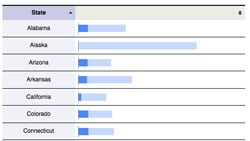(Editor’s note: Making sense of our new - and ever changing - landscape requires piecing together your stories and observations neighborhood-by-neighborhood and state-by-state. We need your help tracking the stimulus in your state. Sign up here, and we'll notify you of timely ways to contribute to our coverage.)
Oklahoma and Illinois have made the most progress in securing stimulus money for road and bridge projects while other states, such as Florida and Ohio, haven't had any projects approved, according to an analysis of federal transportation data.
 President Obama announced this week that the U.S. Department of Transportation approved its 2000th stimulus project, committing about $6.5 billion of the $27 billion in available highway funding.
President Obama announced this week that the U.S. Department of Transportation approved its 2000th stimulus project, committing about $6.5 billion of the $27 billion in available highway funding.
The list of projects ranges widely from cleaning and painting steel supports on the Kuwaikahi bridge in Hawaii to repaving a stretch of interstate in Mattamiscontis, Maine. Costs range from $81 million to rehabilitate Interstate 295 in suburban Philadelphia to $5,700 to pour asphalt on a road in Carbon County, Utah.
Most of the projects haven't started yet and there are no estimates of how many jobs have been created. But taken together, the 2,080 projects provide the most comprehensive look yet at how the states are spending stimulus transportation money.
Illinois has had the most projects approved with 249 and the most funding at $606 million.
New Jersey has three of the most expensive projects on the list. In addition to the most costly I-295 project, there's $70 million to replace the Route 52 Causeway on the Jersey Shore and $45 million to raise two bridges over a flood-prone street in Bergen County.
Nearly $1 billion is headed for bridges, including many in need of repair. Among those the federal government has designated as "structurally deficient" are a bridge over abandoned railroad tracks in Yonkers, N.Y. and a crumbling Depression-era bridge in Tuscumbia, Missouri – which the governor claimed as the first stimulus project shortly after the bill was signed into law in February.
Some states are moving faster than others. According to the stimulus act, states have until the end of June to spend half their share of highway funding or risk losing it. Two months after Obama signed the stimulus, nine states have already met that requirement.
Oklahoma has already received approval for two-thirds of its funding and awarded contracts on some $200 million worth of road work.
Its biggest project is rebuilding eight miles of Interstate 40 west of Oklahoma City, where some of the concrete hasn't been replaced since the 1960s, when it was still called Route 66, said Gary Ridley, director of the Oklahoma Department of Transportation.
Sensing a coming stimulus package, the state started developing a project list in October. When money became available in March, Oklahoma submitted its first requests within hours.
"We may have read the tea leaves a little earlier than others," Ridley said. "We've been working on this since before the election."
Six states – Florida, Ohio, Georgia, Virginia, Idaho and Alaska – haven't had projects approved yet mainly because they haven't submitted any. State transportation officials attributed the delays to bureaucracy, an abundance of caution and a desire to get as much public input as possible.
The Florida budget commission approved its list of 500 projects on Wednesday, a required step before the state could move forward with the Federal Highway Administration. The Sunshine State was also bogged down by having 26 regional planning organizations that all had to meet, approve their local projects and send them to the state, said David Lee, the Florida DOT's administrator of policy and planning.
Virginia's state transportation board is scheduled to vote on its project list today.
"Unlike some other states, when there was a supposition of stimulus funding, when there was no bill passed, we didn't start working on a list of projects," said Virginia DOT spokesman Jeff Caldwell. "We waited until we saw what the provisions were before we began the process."
In Ohio, deputy transportation director Scott Varner said its list is under review.
Ohio waited until end of March to submit its list because it wanted to comb through 4,600 ideas that were submitted by the public through its stimulus Web site.
"It was a process that allowed cities and counties and individuals across the state to submit proposals to the state as to what we might fund with transportation dollars," Varner said.


